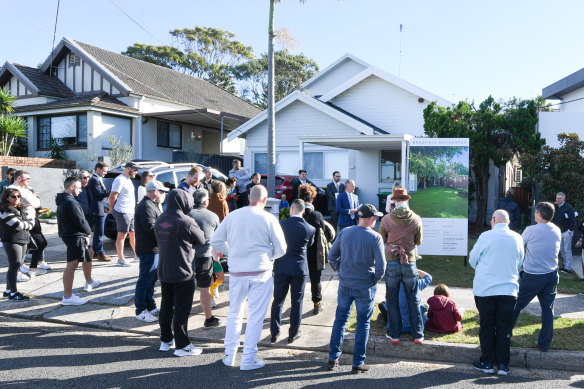This risky home loan type is on the rise as homeowners try to stay afloat
By Sue Williams
More struggling homeowners are switching to interest-only repayments as the share of the riskier home loan type reached its highest levels since 2019, leading to fears of a mortgage cliff in years to come.
The percentage of home loans on interest-only terms hit 20.3 per cent in the June quarter, only a shiver below the high of 20.4 per cent at the same time in 2019, CoreLogic analysis of APRA data found.

Experts warn of the risk of switching to interest-only terms as the share of this home loan type inches higher.Credit: Peter Rae
That proportion has been trending higher for some time. The share of interest-only loans rose from 19.8 per cent last quarter, 19 per cent at the end of 2023 and the low of 17.9 per cent in June 2020.
However, the figure remains below the historic highs of the mid-2010s when investors flooded the market.
CoreLogic economist Kaytlin Ezzy said the rising trend of borrowers choosing interest-only repayments driven by fast rising interest rates that have remained high and cost of living surges.
There’s also evidence that there are more investors, who are often fond of these loans, as they can claim higher tax deductions.
“The participation of investors is the other thing driving these loans at the moment,” Ezzy said. “In July, investors made up 38.3 per cent of the value of new housing related to financing, which was up from the decade average of 33 per cent.
“Rents have increased substantially over the past couple of years, but a lot of investors are running on a negative cash flow and are shifting to interest-only. They tend to be more motivated by the potential for capital gains rather than cash flow.”
Many hope the value of their property will continue to rise, or pay off their loan if they sell. But that can be risky too as property price growth has slowed with a third of suburbs already in decline.
Yet homeowners are eager for some relief from crushing principal and interest repayments due to the high interest and inflation, said Rebecca Jarrett-Dalton, mortgage broker of Two Red Shores, with some banks now even initiating interest-only loans.

Mortgage holders are switching to interest-only in the cost of living crunch in a bid to stay afloat.Credit: Peter Rae
“I’ve had a number of clients moving to interest-only loans because of hardship,” Jarrett-Dalton said. “Some clients are putting tenants in the house and moving back in with parents to live rent-free with mum and dad, while others are renting out their homes and renting somewhere else themselves that’s more economic.”
She said those switching to interest-only were hoping to ride out the storm after drawing down on COVID savings and were banking on falling interest rates or extending the interest-only period.
“This could definitely lead to a problem in five years time when a whole bunch of people are trying to come off interest-only and trying to refinance,” Jarrett-Dalton said. “They’ll be hoping that their circumstances improve by then, but they might not.”
“Paying interest-only is cheaper for a set period of, say, five years, but then, when you have to go back to paying principle and interest, you’re having to pay it back over 25 years instead of your original, perhaps, 30 years. So that could be a mortgage cliff that’s very difficult for some.”
LogiX Financial Services director Murray Katz warned mortgage holders of the mounting problems if interest-only terms are extended as it leaves the majority of the mortgage debt unpaid and a shorter period left to settle it
“At the end of any interest-only period, most people will have to consider the cash flow consequences of the increased repayment of the principal and interest,” he said. “The interest rate will be reduced because the interest-only rate is higher, but there will be a jump in payments because of the considerable amount of the principal.
“Those struggling with interest-only currently will certainly have more problems later and feel more pain. It may be particularly hard for a lot of tradespeople and the other self-employed who are obviously subject to the economy and the state of the local industry.”
Some people may also have selected to pay interest-only to preserve their flexibility in terms of cash flow, so they can use what spare money they might have for other things, added Angus Gilfillan, chief executive and co-founder of mortgage brokerage Finspo. The influx of investors paying interest-only, in particular in Perth, Brisbane and Adelaide, where price growth is the strongest, was boosting numbers too.
“There’s a portion of customers who’ve been paying interest-only for hardship reasons who’ll be impacted when they have to move to paying off the principal too,” Gilfillan said.
“I don’t think it will affect as many people as the mortgage cliff did, when they moved from a fixed rate of 1.8 per cent to a variable rate of 6.5 per cent. But for some people that will still be tough, and they’ll face genuine hardship.”